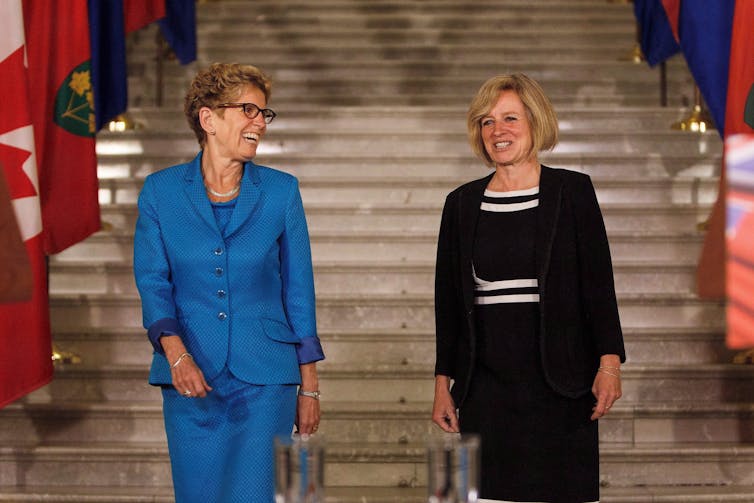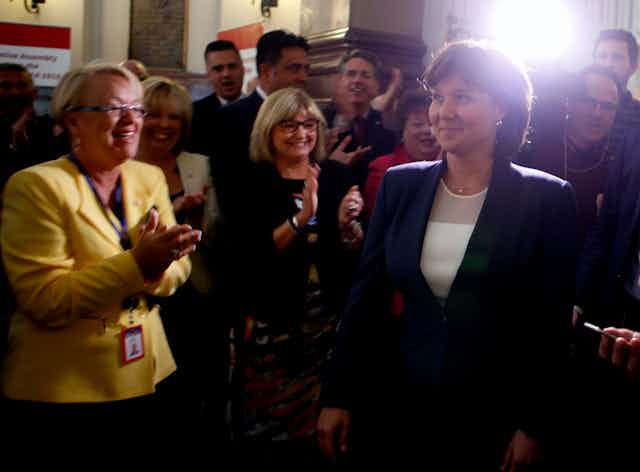British Columbia Premier Christy Clark’s government lost a non-confidence vote Thursday, paving the way for the NDP to form a government. But Clark nonetheless made history last month when she became the first female premier to win a second election at a time when Canada’s provinces are increasingly fertile ground for women in political leadership roles.
For a few months in 2013, half of the provincial premiers were women, a rare moment of gender parity.
With Clark’s defeat Thursday, two women now stand at the helm of sub-national governments: Alberta’s Rachel Notley and Ontario’s Kathleen Wynne. A total of 11 women have occupied premiers’ offices. Compared to the federal level of government, where only one woman has held the top job, the provinces seem relatively woman-friendly.
Why have so many women risen to the top provincially? One reason is the larger number of women in “the pipeline” as legislators, cabinet ministers and party leaders. The most recent elections saw the percentage of women in provincial legislatures climb to 30 per cent overall. The B.C. legislature boasts the highest number of women at 39 per cent, while women make up only 16 per cent of legislators in New Brunswick. With some exceptions, women regularly hold more than a third of the provincial cabinet positions. Provincial politics is well-primed for electing women, providing a rational trajectory to consider running as leader.
On the other hand, why so few? As we approach Canada’s 150th birthday, it seems shocking that only 11 women have served as premiers. It was 1993, after all, before a woman won a general election to become premier — Catherine Callbeck of Prince Edward Island, and she resigned less than four years later.
Some researchers point to a hostile political environment for female leaders in Canada.
Female politicians often demeaned
Political scientist Sylvia Bashevkin sums it up with the apt phrase: women plus power equals discomfort. There continues to be unease with the idea of women in elite leadership roles. Bashevkin argues that when women are in the position of premier, their actions are often derided and demeaned. They are viewed as less effective than their male counterparts, and their leadership skills are questioned because of their gender identities.
There is no shortage of examples. Clark has been dubbed a “photo-op princess” and in a leadership debate, she was castigated by NDP leader John Horgan for “wanting to be the centre of attention.” An election advertisement created by the B.C. Federation of Labour depicted Clark as a pantsuit- and pink-hardhat-wearing villain who scored points for every photo-op and school closure.

In Alberta, the threats against Notley have been particularly nasty and violent. Indeed, she’s the most threatened premier in the province’s history. Numerous sexist rants and several assassination threats have circulated, many of which were made on social media. But political adversaries have been part of the problem, too. Last year, Wildrose leader Brian Jean told an audience: “It’s against the law to beat Rachel Notley.”
Wynne has faced sexism and homophobia
For Ontario’s Wynne, the blowback is not just misogynistic, it’s also homophobic, with rants on Facebook and other social media websites that are threatening and antagonistic. Obviously, these types of nasty exchanges are part and parcel of any politician’s life, but the sexist undertones for female premiers suggest some Canadians are uncomfortable with a woman in charge.
Political parties, especially those with access to power, also seem uneasy about women in the top jobs. With the exception of the Northwest Territories and Nunavut, which do not have party systems, party leadership is the only pathway to the premiership. But most women are chosen to lead minor parties, or electorally decimated parties. Few win the leadership of a party in office, or a party poised to form the government. Rachel Notley was leader of the fourth party in the Alberta legislature when she staged the NDP’s come-from-behind victory.
The “glass cliff” phenomenon suggests that women assume leadership positions when the organization is in a risky or precarious state and the chances of failure are ridiculously high. Most of the women premiers rose to the top when their party was tainted by scandal or growing stale from multiple terms in office. Alison Redford exemplifies the trend, taking on the leadership of a party that had governed Alberta for over 40 years. She resigned before the Progressive Conservatives were toppled in the 2015 election campaign.
The ‘glass cliff’ is steep
Wynne presents another good example of the glass cliff syndrome. Her predecessor Dalton McGuinty saw the party’s number of seats decline to minority status after its third election campaign. In 2014, Wynne led the party to majority status in Ontario, making her the first female premier for Ontario and the first openly gay premier in the country. Now there are predictions that she is destined for defeat. While Wynne’s party may still be popular, she as leader is not.
That the B.C. Liberals under Clark’s leadership won a fourth term in office after governing the province since 2001 is noteworthy. Clark’s narrow win of a second term is a significant first for a woman premier. She is also Canada’s longest-lasting woman premier, at just over six years in office. But as she concedes, her new government isn’t likely to survive a vote in the legislature.
Surprisingly, there has never been a systematic study of the career paths, media coverage and representative impact of women as premiers. As more attention is paid to the gender disparity in our political halls of power, more research is integral to determining what it will take for women to govern for more than one term, and what difference their presence in the premier’s office makes.

